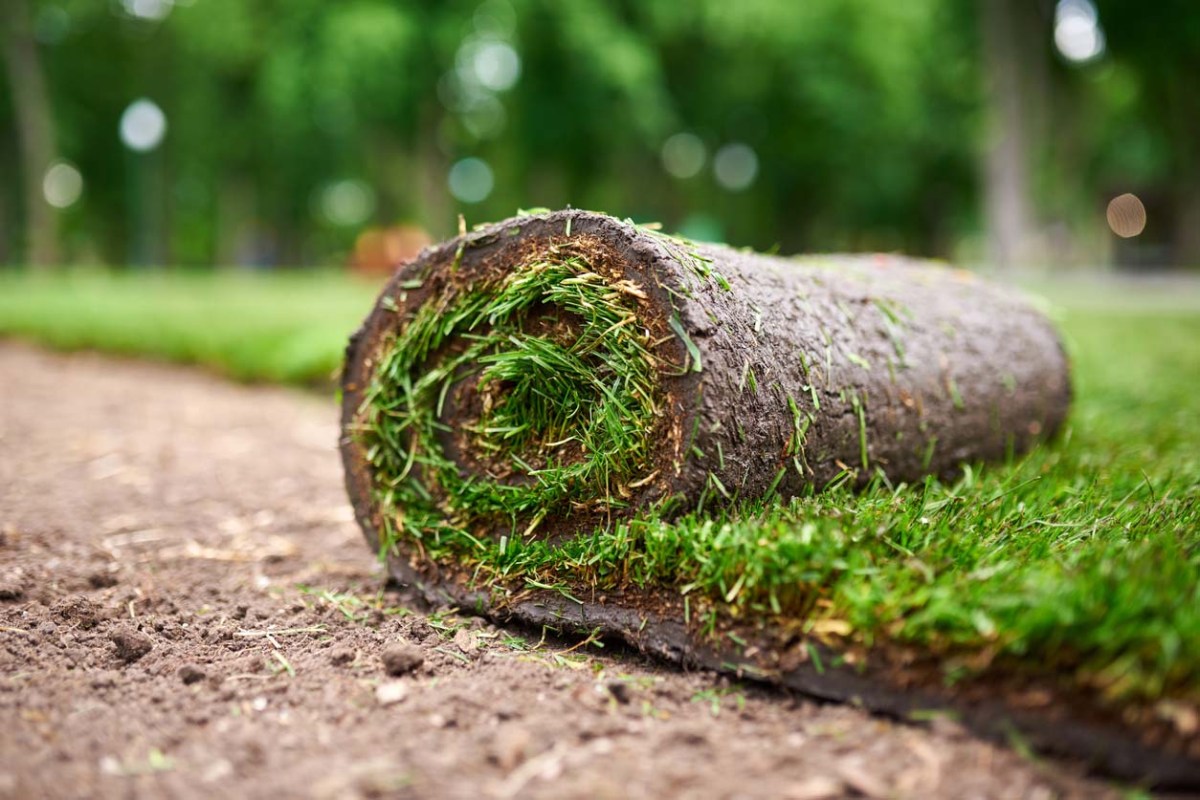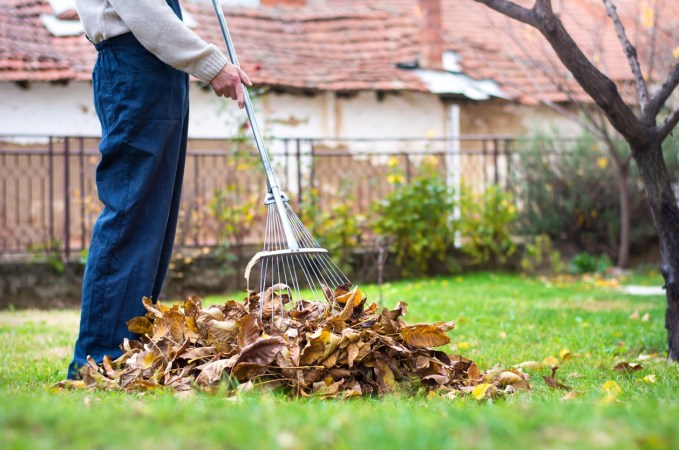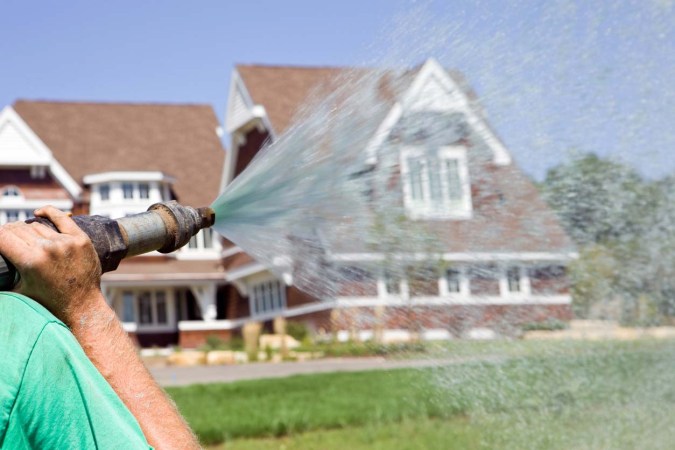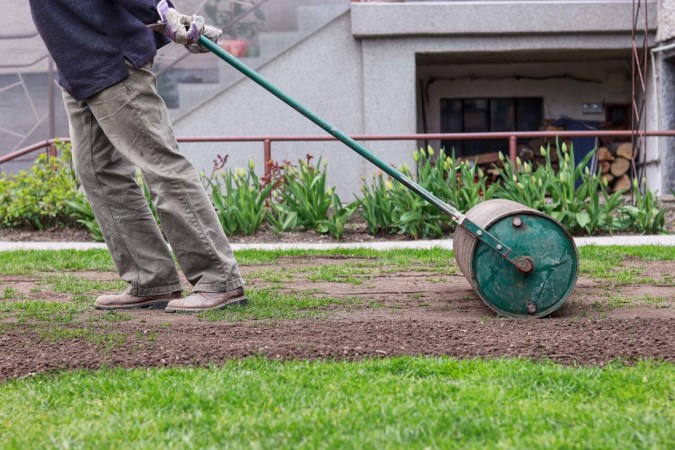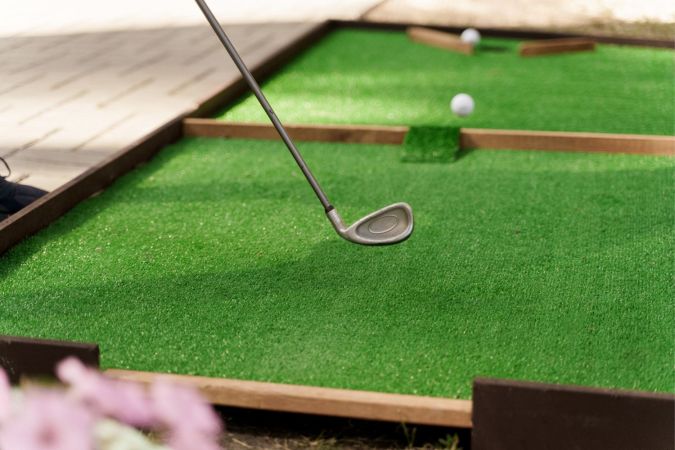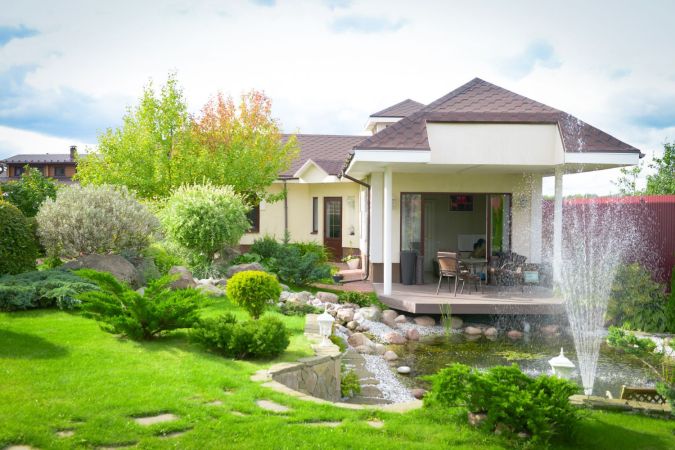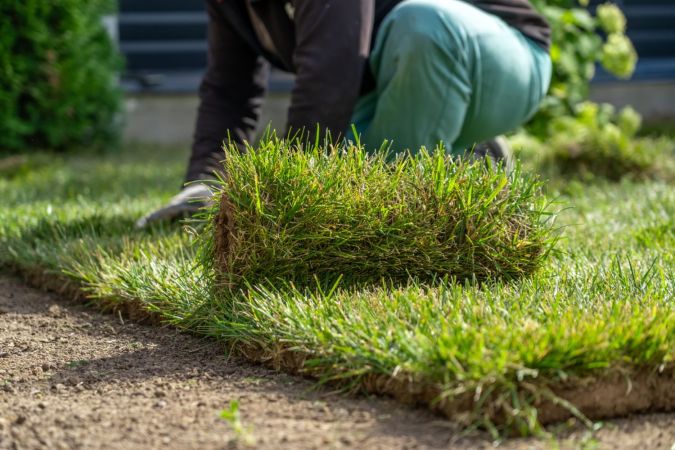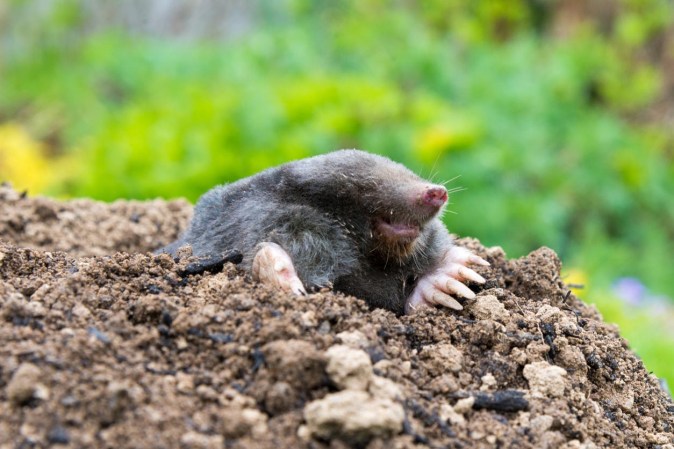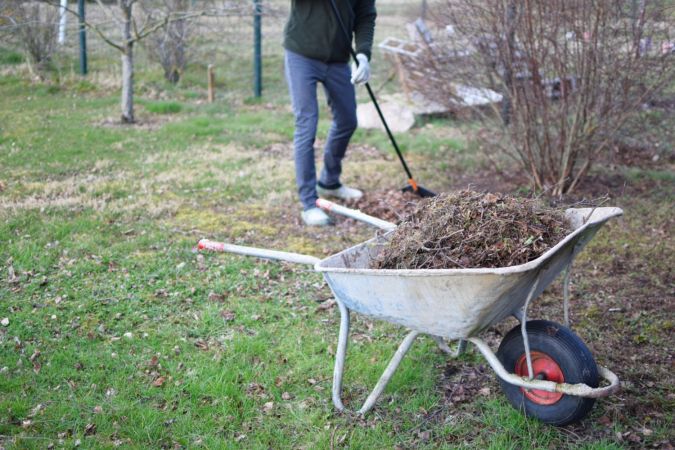We may earn revenue from the products available on this page and participate in affiliate programs. Learn More ›
Highlights
- It typically costs between $1,072 and $2,978 to install sod in a yard, though the national average cost is $2,006.
- The main factors that can affect the cost of sod installation include the type of sod used, the size and shape of the yard, the accessibility of the installation area, labor and delivery fees, and the home’s geographic location.
- Laying sod has numerous benefits, including immediate results, flexibility in installation times, prevention of soil erosion, decreased weed growth, and an even lawn.
- Homeowners may be able to install a small area of sod themselves. However, this is a labor-intensive job, and many homeowners will want to leave sod installation to a professional who knows how to install sod for long-lasting results.
Dreaming of a plush, vivid lawn? Installing sod provides an attractive lawn nearly immediately, while also boosting curb appeal, helping to control weeds, and reducing soil erosion. Sod, or turf, is grass grown on soil at a sod farm that can be transplanted into a yard for an instant lawn. It is typically held together by the grass roots or a thin biodegradable layer of netting or organic materials. Laying sod is a quick way to establish a new lawn without having to wait for the grass to grow from seed.
Sod installation rates can vary due to regional differences, the type of grass, labor, the size and shape of the lawn, and other factors. According to Angi and HomeAdvisor, sod installation costs between $1,072 and $2,978, with an average cost of $2,006. Although somewhat pricier than other lawn options, sod allows homeowners to enjoy healthy, green grass within a matter of days, which can make it worth the investment.
Factors in Calculating Sod Cost
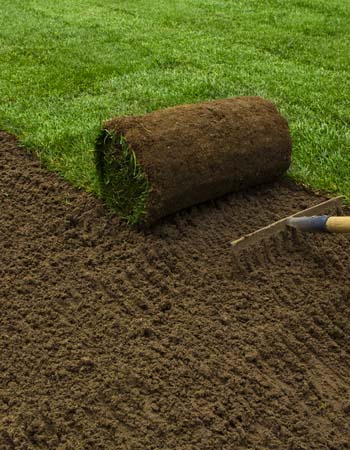
Determining the cost of sod installation depends on a few critical factors. These include the type of sod used, the size and shape of the lawn, the accessibility of the yard, delivery and labor fees, and geographic location. Homeowners will want to keep all of these factors in mind when setting a budget for sod installation.
Sod Type
The variety of grass chosen is one factor that dictates sod installation costs. Sod prices range from $0.35 to $0.85 per square foot, depending on the types of grass. Most grass is sold by the square foot or as a pallet of sod. Homeowners can expect to pay around $450 to $900 per pallet of sod, installed. Many factors play a role in choosing the best type of sod for a property, including climate; soil conditions; how much traffic the lawn will get from guests, children, and pets; and resistance to disease, pests, and fungus. The different types of sod and their costs will be explained in a section below.
Yard Size and Shape
Lawn size is probably the most significant factor when it comes to determining the project price. Of course, the larger the yard, the pricier it will be to order and lay sod. Experts recommend purchasing 5 percent more sod than the lawn measurement calls for since sod rolls need to be cut to fit certain areas of the lawn. Below are some average sod prices based on yard sizes.
| Yard Size | Average Sod Installation Cost |
| 1,000 square feet | $1,500 |
| 2,000 square feet | $3,000 |
| 3,250 square feet | $4,875 |
| 4,500 square feet | $6,750 |
| 6,000 square feet | $9,000 |
| ¼ acre | $16,350 |
The shape of the lawn also plays a major role in cost. Sod comes in a square or rectangular shape. Therefore, it’s more challenging for installers to cut and lay the sod on lawns that have curved edges and irregular shapes. Projects that are more complex due to yard shape can cost up to 20 percent more in materials and labor.
Yard Accessibility
Accessibility issues can raise the price of a sod installation project. If it is difficult for the landscapers to get their truck and equipment to the yard, such as having to enter through a narrow passageway, they will probably charge more. Also, if there are obstacles in the yard, such as stepping stones, raised garden beds, bushes, or trees with big roots, a homeowner can expect to pay 10 percent to 20 percent more since the project will take longer. These situations, along with curved lawns and steep hills, add to the complexity of the work since landscapers have to cut and shape the sod.
Labor
Labor costs impact the overall budget. Professional sod installation includes all equipment and tools needed to prepare and install the new sod. The average cost of labor to install sod is $0.50 to $1.00 per square foot, or $35 to $80 per hour. It usually takes about 1 hour to cover 25 yards, which equates to 225 square feet. For installers who charge a rate that includes both labor and materials, homeowners can plan on spending between $1 to $2 per square foot. Prices will be on the higher end if the lawn is sloped, difficult to access, or has an irregular shape.
Delivery Fees
Sod delivery fees typically range from $65 to $230 per truckload. Some landscaping companies include delivery in their price estimate, while others charge a separate fee, so homeowners will want to be sure to ask. Delivery fees depend on how far the customer lives from the supplier and how much sod is in the order. Sometimes companies will waive delivery fees with a large enough order. To save money, homeowners may want to consider picking up the sod in their own truck or trailer. It may also be cost-effective to rent a truck for the day, which typically costs around $130.
Geographic Location
Location can influence the cost of sod installation. Those who live far away from sod suppliers can generally expect to pay more. Sod usually costs more in urban areas and in places with heavy home construction due to the high demand for new grass. Another factor with regard to location is climate. Location dictates the type of grass that thrives in a particular area, which can limit selection and affect price. Below are some average price ranges for sod based on geographic location.
| City | Average Sod Installation Cost |
| Cape Coral, Florida | $840 to $2,600 |
| Chicago, Illinois | $880 to $2,100 |
| Indianapolis, Indiana | $800 to $2,200 |
| Los Angeles, California | $1,400 to $3,100 |
| Minneapolis, Minnesota | $870 to $2,200 |
| Raleigh, North Carolina | $1,250 to $3,500 |
| Sacramento, California | $1,500 to $3,050 |
| Seattle, Washington | $1,370 to $3,270 |
| Trenton, New Jersey | $1,700 to $4,375 |
| Tulsa, Oklahoma | $1,100 to $2,300 |
Additional Costs and Considerations
Preparing for installation and maintaining fresh sod over time requires some extra steps that homeowners will want to consider. These factors can add to the overall cost of taking care of the lawn. Some of these add-on costs include removing old grass and weeds prior to sod installation, grading or leveling the yard, testing and preparing the soil, and installing a sprinkler system.
Old Grass and Weed Removal
Before a homeowner lays new sod, existing grass and weeds need to be removed from the entire lawn, especially if the yard has been neglected over time. Landscapers will need to till the existing layer of soil to provide a freshly aerated base for the new sod. Another option is to lay and level the topsoil before adding new sod. This process requires special equipment, so homeowners can expect to pay between $1 and $3 per square foot on average for land leveling and $12 to $55 per cubic yard for topsoil. Of course, prices vary depending on the amount and complexity of the work. DIYers can rent a sod cutter for $70 to $100 per day.
Land Grading or Leveling
If the yard is uneven or sloped, it may need to be regraded or leveled before the new sod is installed. This service typically costs $0.40 to $2 per square foot, or a total of $1,000 to $3,500, including labor and equipment. Homeowners will want to note that gates and/or fences may also need to be removed to get this work done.
Soil Testing
Soil testing is important in determining which type of grass will grow best in a particular location and what nutrients need to be added to support the grass. A professional soil test costs between $20 and $100, with $60 being the average price. If the test shows issues with the soil conditions, it may be necessary to add fresh topsoil.
Soil Preparation and Topsoil
Soil plays a huge role in having a healthy lawn. Without adequate soil quality, the grass won’t be able to take root and establish roots to thrive. Testing may indicate that the soil needs to be modified or amended before the sod can be installed. Adding fresh topsoil can add to the cost of the project. Homeowners will want to plan to pay $2 to $6 per bag or $10 to $50 per cubic yard for new topsoil, plus $14 to $135 for delivery.
Fertilizer and Herbicide
In order to give sod the best start possible, it is important to use the right fertilizer and herbicide on the lawn to help stimulate the roots so they grow strong and deep in the ground. Fertilizer or herbicides cost between $200 and $500 per treatment, depending on the size of the lawn, or $0.02 to $0.08 per square foot.
Sprinkler System Installation
If a sprinkler system isn’t already in place, it’s a good idea to install one at the same time as sod installation. The sprinkler system will help the grass stay adequately hydrated and continue to thrive. Plus, a sprinkler system will result in less work for the homeowner. A new sprinkler system costs in the range of $1,700 and $3,500, depending on the size of the lawn and the type of system chosen. There may be some cost savings by installing sod and sprinklers at the same time since there would be less labor involved as opposed to doing it as two separate projects.
Sod Alternatives
When considering the cost of sod installation, it’s helpful to evaluate other lawn options as well.
- Reseeding, or overseeding, is the process of spreading fresh grass seed over existing lawn either to encourage thicker grass growth or to repair sections. While other methods result in faster growth, this option is the least expensive. The typical cost to reseed a lawn is $436 to $1,689, with an average cost of $1,038.
- Hydroseeding is a fast, cost-effective, eco-friendly way to distribute liquid grass seeding to jump-start a new lawn. This method involves spraying a slurry consisting of grass seed, water, mulch, and fertilizer to grow a lush lawn. It is particularly attractive for large lawns and those with slopes that need help to control soil erosion. The cost of a new lawn using hydroseeding ranges from $500 to $4,000, with a national average cost of $1,000.
- Artificial turf installation is also an option. The typical range for artificial grass costs is between $2,961 and $7,792, with a national average of $5,358. Benefits of artificial grass include saving water; pest, weed, disease, and drought resistance; minimal maintenance; cost effectiveness; and curb appeal.
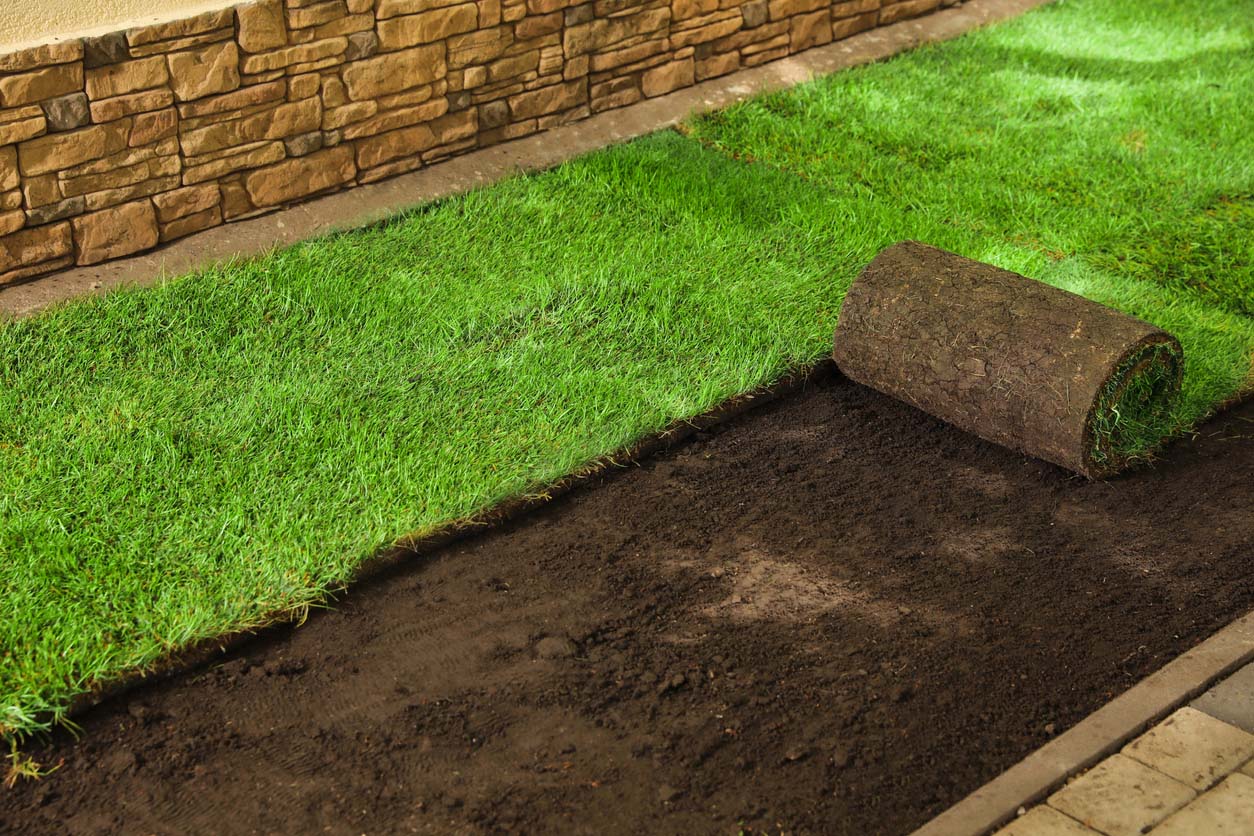
Types of Sod
Grass varieties drive the total price of sod installation. Most sod is sold by the pallet or square foot, and homeowners can expect the cost per pallet to be between $150 and $450, depending on the variety of grass. While choosing the type of sod is based on personal preference, homeowners will notice that there are limitations due to availability, location, temperature, and precipitation, so not every variety will thrive at all properties.
Sod also comes in three grades: economy or utility grade, mid-grade, and high grade, all of which have different price points. Economy-grade sod is the most affordable option at $0.20 to $0.30 per square foot, mid-grade sod costs $0.50 to $0.65 per square foot, and high-grade sod runs $0.70 to $0.80 per square foot. Below are the most common types of sod available and their price ranges.
| Type of Sod | Average Cost per Square Foot (Materials Only) |
| Bahia | $0.20 to $0.40 |
| Bentgrass | $0.50 to $0.70 |
| Bermuda | $0.35 to $0.85 |
| Centipede | $0.75 to $0.85 |
| Fescue | $0.35 to $0.65 |
| Kentucky bluegrass | $0.35 to $0.40 |
| Marathon | $0.60 to $0.65 |
| Ryegrass | $0.35 to $0.65 |
| St. Augustine | $0.35 to $0.75 |
| Zoysia | $0.40 to $0.60 |
Bahia
Bahia is a hearty, low-maintenance, warm-season grass that costs $0.20 to $0.40 per square foot. It grows best in hot, dry conditions with full sun and is a drought-tolerant grass. It is popular in the southern United States but is not suitable for colder climates since it cannot survive freezing temperatures.
Bentgrass
Bentgrass costs $0.50 to $0.70 per square foot and is highly resistant to disease and pests. However, it can be slow to turn green in the spring and tends to need more water and fertilizer than other types of sod.
Bermuda
Bermuda is a resilient grass that costs between $0.35 and $0.85 per square foot. It grows best in warm climates like the southern United States, where it can get a lot of sun and good drainage. It grows quickly and is resistant to heat, drought, disease, salt, and traffic.
Centipede
Popular in the southeastern United States, centipede grass costs between $0.75 and $0.85 per square foot and can withstand both heat and drought; it also fares well in shade. It’s relatively low maintenance, making it a popular choice for homeowners who prefer to be hands-off when it comes to lawn care.
Fescue
Fescue is one of the most popular cool-season grasses and is affordable at $0.35 to $0.65 per square foot. Available in both fine and tall varieties, it thrives in cool, temperate climates and in shady conditions. It is also durable and resilient, able to survive freezing temperatures and resistant to heat, drought, and disease.
Kentucky Bluegrass
Kentucky bluegrass costs $0.35 to $0.40 per square foot and can thrive in shady, cool climates and winters, but it will not survive heat and drought. This cool-season grass is one of the most popular grass options throughout the country. It does well with a lot of foot traffic, but it is not resistant to heat and drought.
Marathon
Marathon grass is one of the toughest cool-season varieties, and it has a healthy, rich color. Its deep-reaching root system means it doesn’t require as much watering as other sod varieties, and it’s therefore able to withstand times of drought. Marathon sod costs between $0.60 and $0.65 per square foot.
Ryegrass
Ryegrass costs about $0.35 to $0.65 per square foot and thrives in cool, rainy climates; however, it will need extra attention to survive hot and dry conditions. It germinates quickly, which makes it a popular choice for those who want immediate results.
St. Augustine
St. Augustine can fend off pests and weeds and costs $0.35 to $0.75 per square foot on average. Also incredibly resistant to heat and humidity, this type of grass is a wonderful choice for coastal locations. However, it will not do well in areas that experience heavy foot traffic.
Zoysia
Zoysia sod costs in the range of $0.40 to $0.60 per square foot. This warm-season grass tolerates heat, drought, and light shade well and does not need much water or maintenance. It can also handle heavy foot traffic.
Benefits of Laying Sod
While the up-front price of sod may concern some homeowners, a healthy lawn can provide several benefits to the overall property. Sod offers many advantages compared with other lawn options, including instant results, flexibility in when it can be installed during the year, erosion prevention, and more.
Instant Results
Since sod is grown on a farm before it even reaches a yard, homeowners see immediate results with no waiting necessary. While it takes about 2 to 3 weeks for sod roots to become well established, this is still a much quicker process than starting with seed, which can take several weeks to months to grow and establish a root system.
Installation Flexibility
Compared with grass seeding, which requires certain temperatures and moisture conditions for the seed to be installed, sod has a longer installation window. While it is best to avoid installing sod during extreme cold or hot weather, sod tends to be more resilient than seed and can grow even during some unfavorable weather conditions.
Soil Erosion Prevention
For those concerned with soil erosion control in their yard, sod is the best option, especially for sloped areas. It does an effective job keeping soil in place due to its well-established root system. Mature grass—which is what sod is on day 1—helps prevent the loss of topsoil due to wind, rain, and other natural processes. On the other hand, fresh seed can easily get washed away in a storm.
Decreased Weed Growth
Sod is also known for minimal weed growth since it is grown professionally and watched over closely. While there is no guarantee that sod will have no weeds at all, high-quality sod typically has few to no weeds.
Evenness
Sodded grass is particularly attractive for producing full, even-looking lawns without any bare spots. This is harder to achieve with seed, which often ends up looking patchy.
Sod Installation: DIY vs. Hiring a Professional
Although a DIY installation is possible when it comes to laying sod, it is a lot to take on. It is both physically challenging and time consuming; some estimates suggest it can take up to 40 hours of work to lay sod. DIY may be possible for a small area and if friends and family members are willing to help, but in general, calling in one of the best sod installation services is recommended.
As mentioned above, sod installation can involve many detailed steps: clearing the current yard to remove debris and obstacles, regrading or leveling the yard, testing the soil and understanding what the results mean, being familiar with all the different grass choices, and knowing how to take care of the new sod.
It is also important to recognize all the materials required to get the job done, such as shovels, home soil test, garden knife, rake, tape measure, tamper, wheelbarrow, and fertilizer spreader, not to mention fertilizer and the sod itself. Additional equipment will also need to be rented, including a rototiller, sod cutter, and lawn roller. All of this adds up to an estimated $2,000, so keep that in mind when deciding whether DIY is more economical than hiring a professional.
On the other hand, hiring professionals has many benefits. It saves time, energy due to physical labor, and stress for homeowners. The pros will take care of all the heavy lifting, arrange for sod delivery, prepare the soil, handle regrading or leveling, install sprinkler systems, and manage all the other details involved. They also already have all the equipment on hand for the project. Finally, a landscaping company or sod installation company can provide a professional touch that may be more difficult to achieve as a DIYer.
How to Save Money on Sod Cost
With so many factors influencing the cost of laying new sod and the concerns about the hefty price tag that comes with sod installation, homeowners will benefit from the following tips to help save money on the sod installation process.
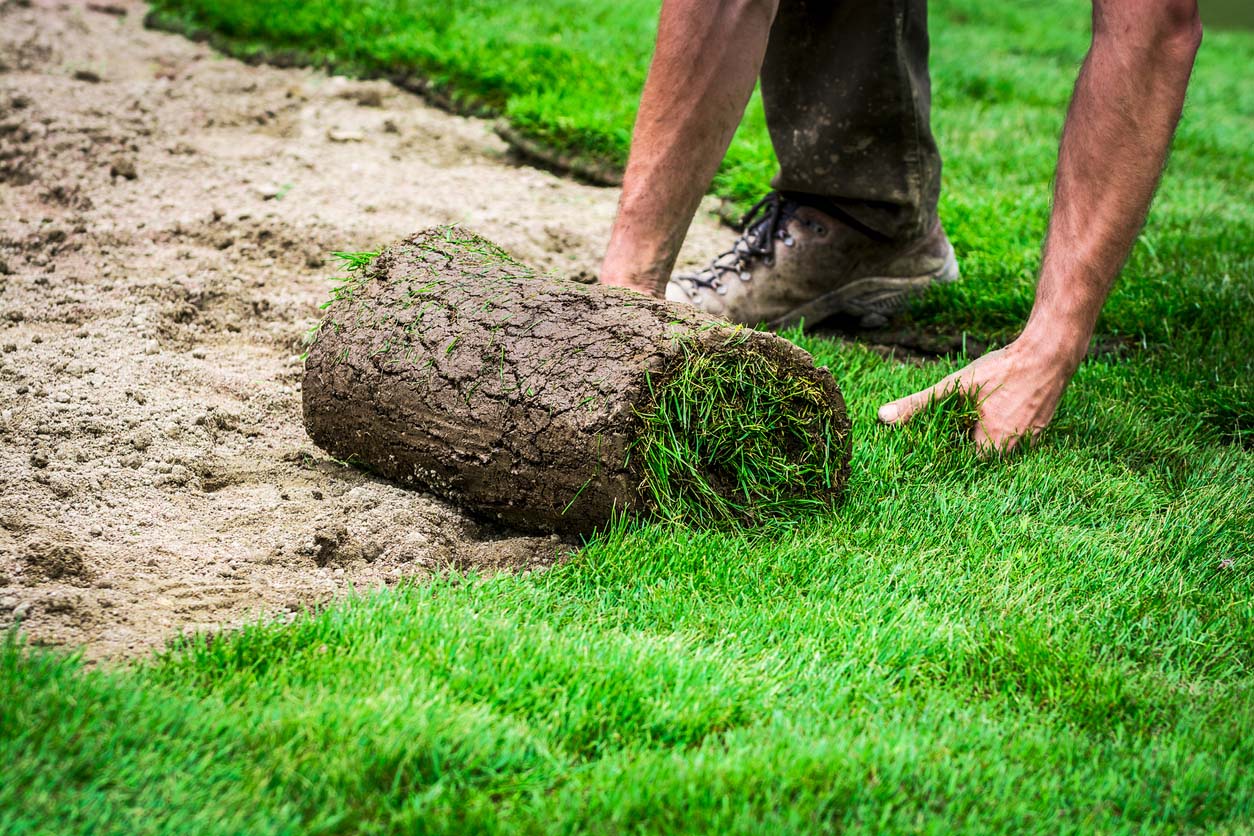
- Stick to the basics. Choose one of the more economical varieties of sod that grows well in the local climate. Lower-priced species include bahia, Kentucky bluegrass, and ryegrass.
- Install in spurts. Determine if the whole lawn needs to be replaced or if it can be done gradually. Cut expenses by installing the sod in sections spaced out over time. As the grass grows and spreads over a couple of years, dead spots can be filled in.
- Take the DIY route. Depending on experience, interest, size of the project, and time availability, installing sod as a DIY project can potentially save some money.
- Avoid delivery charges. Depending on location and how much sod is needed, homeowners can reduce the project budget by picking up sod themselves. This especially works well for smaller projects and is best suited to those who have a truck or trailer on hand or have a friend or neighbor they can borrow one from.
- Do your own prep work. By handling prep work such as removal of debris, old grass, weeds, and landscaping, homeowners can save money.
- Use remnants. Look for ways to reuse scrap pieces of sod from previous projects. This works especially well for small areas and when doing patch work on a yard. Contact sod farms, sod installation companies, and even neighbors installing sod to see if they have remnants available.
- Shop around. Compare quotes from the best landscaping companies and sod installation companies before deciding who to hire.
- Look for discounts. Ask if there are discounts based on volume and buying in bulk, during holidays or certain times of the year, for referrals, and when neighbors order sod installation at the same time. Deals may also be available at home-and-garden shows where sod wholesalers and landscaping companies attend.
Questions to Ask About Sod Installation
Asking the right questions before installing new sod can help homeowners feel confident that their new lawn will thrive throughout the year. Below are some helpful questions for homeowners to ask a landscaper or sod installation company regarding the details of their sod installation services.
- Are you licensed and insured?
- Can I review a portfolio of your work?
- Will you come to my house and provide a free estimate?
- Where do you source your sod?
- How do you ensure the sod is fresh and healthy?
- How much time passes between sod harvesting and installation?
- What types of grass are available?
- Will you help me choose the best sod for my property?
- How much sod will I need, and how much extra will you order?
- How long will it take to get the sod once it is ordered?
- How will you prepare the ground?
- What will you charge to remove old grass, debris, or landscaping?
- Do you completely kill existing weeds and grass?
- Will the installers make sure the lawn is level?
- Does installation include fertilizing the sod?
- How long will it take to install?
- Will the installers check and adjust the irrigation heads?
- Will you provide detailed instructions on how to care for the new sod?
- How much does professional lawn care cost?
- How long will I need to stay off the lawn after work is complete?
- How often should I water the new grass considering how much shade and sun it gets?
- Do you offer any warranties or guarantees?
FAQs
The process of installing new sod for the first time can quickly become overwhelming. The following frequently asked questions and their answers can guide homeowners as they decide on the best sod for their home.
Q. What should you put down before laying sod?
Before putting down sod, it is helpful to add topsoil. This is especially important when laying sod over clay and other types of poor-quality dirt—failing to properly prepare the ground will make the cost of a new lawn a waste of money.
Q. How long does sod take to install?
It takes one person about 1 to 1½ hours to install one pallet, or 600 square feet, of sod. Homeowners can expect it to take additional time in areas that are difficult to access and if the sod needs to be cut into unique shapes and sizes.
Q. Can you lay sod over existing grass?
It is not recommended to lay sod directly over existing grass. Although this may seem like a timesaver, it actually could end up killing the sod and causing more work. The grass roots need to make direct contact with the soil to form a root system. Therefore, the old lawn needs to be removed before sod can be laid.
Q. How long does it take for sod to root?
It typically takes 10 to 14 days for new sod to grow a root system. Before this time, the grass is not yet firmly attached to the ground and could move around if disturbed.
Q. How much sod can you lay in a day?
One person can lay somewhere between 2,000 and 4,000 square feet of sod in a day depending on experience and speed.
Q. What time of year is best to lay sod?
The timing depends on the local climate. However, in general, the spring and fall tend to be the best seasons to lay sod successfully since it is cool but not cold and there is steady rainfall.
Q. Can you lay sod without tilling?
It is advised for homeowners to till the soil before laying sod to loosen it up, which makes it easier for roots to grow. They’ll want to go over the ground several times to break up any large clumps in the soil.
Q. Can you mow sod after laying?
Once the sod is down, the new grass can be mowed after about 4 to 6 weeks. Homeowners can either mow themselves or look into the average lawn-mowing cost in their area if they prefer to leave this task to the pros.
Q. How thick is a piece of sod?
A typical piece of sod is about 1 inch thick. However, thickness varies depending on the soil composition and how the sod is harvested.
Sources: Angi, HomeAdvisor, HomeGuide, Forbes, Lawn Love, Saratoga Sod Farm

